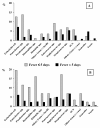Risk factors and outcomes for prolonged versus brief fever: a prospective cohort study
- PMID: 22889136
- PMCID: PMC3580739
- DOI: 10.1186/cc11465
Risk factors and outcomes for prolonged versus brief fever: a prospective cohort study
Abstract
Introduction: Prolonged fever occurs with infectious and noninfectious diseases but is poorly studied in intensive care units. The aims of this prospective multicenter noninterventional study were to determine the incidence and etiologies of prolonged fever in critically ill patients and to compare outcomes for prolonged fever and short-lasting fever.
Methods: The study involved two periods of 2 months each, with 507 patients hospitalized ≥ 24 hours. Fever was defined by at least one episode of temperature ≥ 38.3 °C, and prolonged fever, as lasting > 5 days. Backward stepwise logistic regression was performed to identify the independent factors associated with prolonged fever versus short-lasting fever.
Results: Prolonged or short-lasting fever occurred in 87 (17%) and 278 (55%) patients, respectively. Infectious and noninfectious causes were found in 54 (62%) and 27 (31%) of 87 patients, respectively; in six patients (7%), prolonged fever remained unexplained. The two most common sites of infection were ventilator-associated pneumonia (n = 25) and intraabdominal infection (n = 13). Noninfectious fever (n = 27) was neurogenic in 19 (70%) patients and mainly associated with cerebral injury (84%). Independent risk factors for prolonged fever were cerebral injury at admission (OR = 5.03; 95% CI, 2.51 to 10.06), severe sepsis (OR = 2.79; 95% CI, 1.35 to 5.79), number of infections (OR = 2.35; 95% CI, 1.43 to 3.86), and mechanical-ventilation duration (OR = 1.05; 95% CI, 1.01 to 1.09). Older patients were less likely to develop prolonged fever. ICU mortality did not differ between the two groups.
Conclusions: Prolonged fever was common, mainly due to severe infections, particularly ventilator-associated pneumonia, and mixed infectious causes were frequent, warranting systematic and careful search for multiple causes. Neurogenic fever was also especially frequent.
Figures


Comment in
-
The continuing question of how fever duration is associated with patient outcome.Crit Care. 2012 Nov 9;16(6):166. doi: 10.1186/cc11683. Crit Care. 2012. PMID: 23167923 Free PMC article.
References
-
- O'Grady NP, Barie PS, Bartlett JG, Bleck T, Carroll K, Kalil AC, Linden P, Maki DG, Nierman D, Pasculle W, Masur H. the American College of Critical Care Medicine, Infectious Diseases, Society of America. Guidelines for evaluation of new fever in critically ill adult patients: 2008 update from the American College of Critical Care Medicine and the Infectious Diseases Society of America. Crit Care Med. 2008;36:1330–1349. doi: 10.1097/CCM.0b013e318169eda9. - DOI - PubMed
Publication types
MeSH terms
LinkOut - more resources
Full Text Sources
Medical

